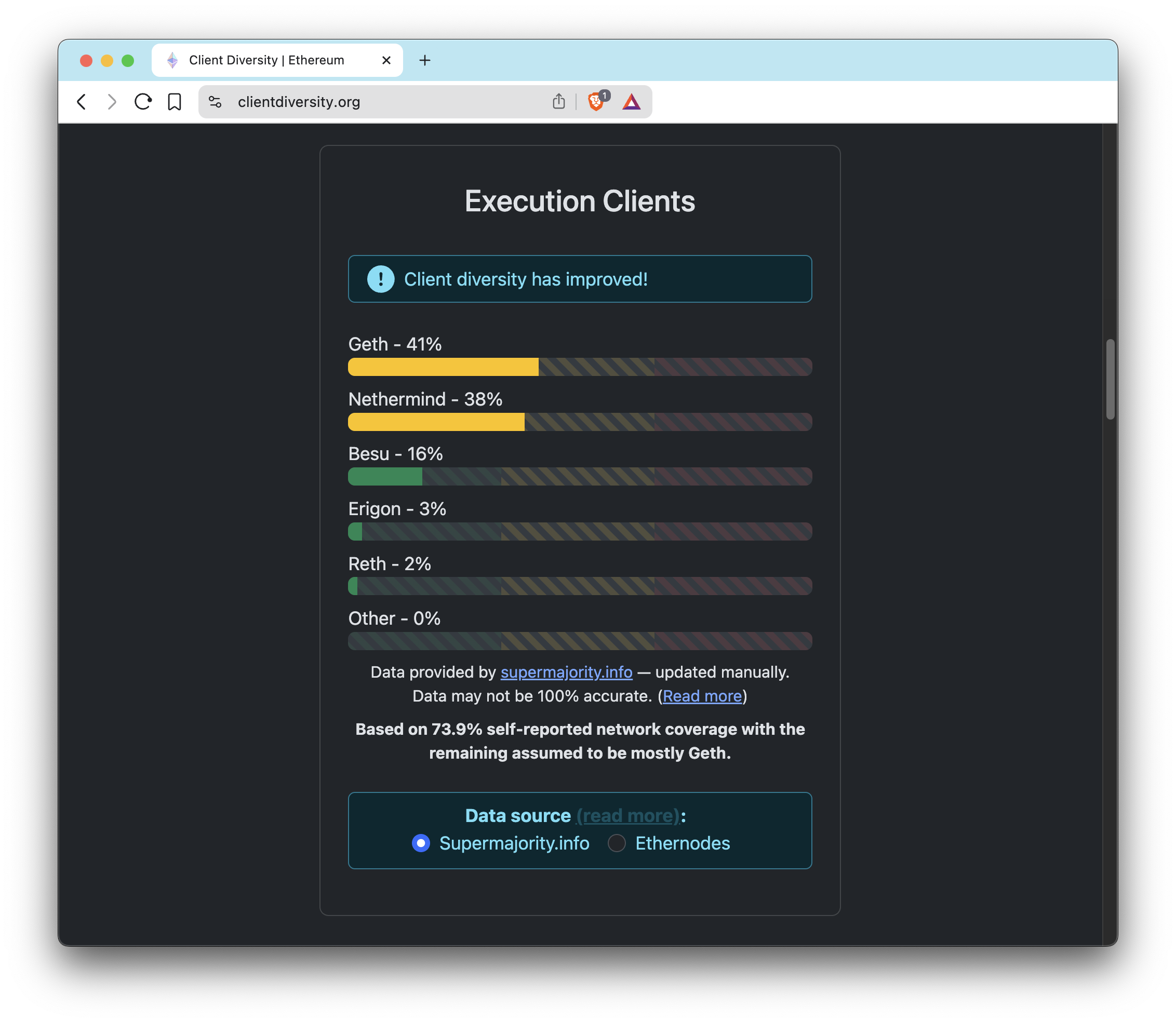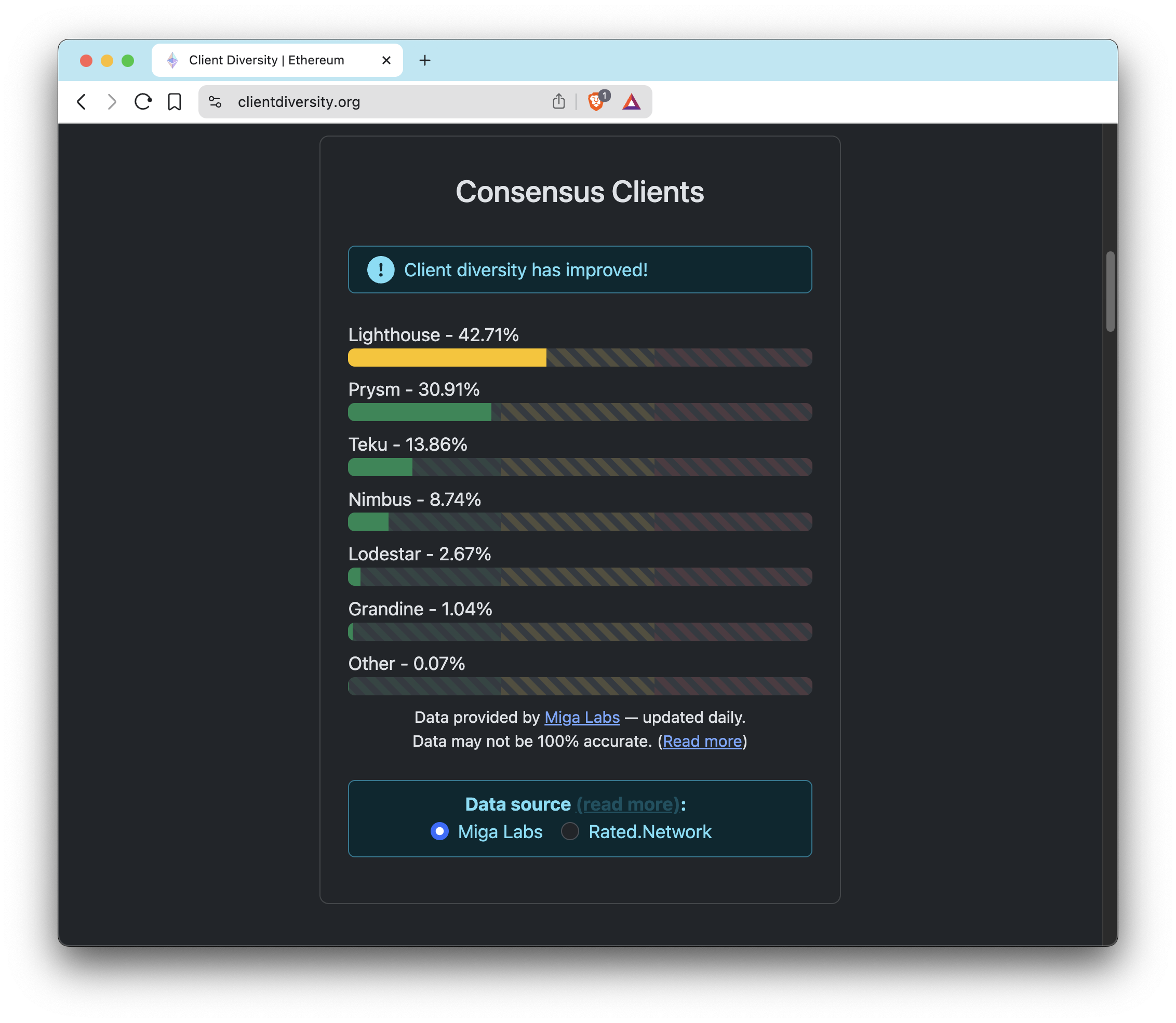8 min read
Overview
When building on Ethereum, understanding the different client types is essential—they impact everything from performance and uptime to network security and decentralization. This guide breaks down Ethereum node types, compares the leading execution and consensus clients, and explains why client diversity is critical for a resilient infrastructure. See how Quicknode helps you build with confidence and flexibility.
What You Will Learn
- The difference between Full, Archive, and Light nodes
- The roles of Execution and Consensus clients in the Ethereum ecosystem
- A comparison of popular Execution Clients
- A comparison of popular Consensus Clients
- How Quicknode provides client diversity and offers ultimate flexibility with dedicated clusters
What You Will Need
- A basic understanding of the Ethereum protocol and its architecture
Node Types: Full, Archive, and Light Nodes
Before diving into specific clients, it's essential to understand the different types of nodes you can run. The type of node determines the amount of data it stores and the functionalities it can provide.
-
Full Node: A full node downloads and verifies every block and transaction, ensuring they adhere to the network's consensus rules. While it maintains the full, current state of the blockchain, it may discard older state data (a process called pruning) to save disk space, with most clients keeping the state data for only the most recent 128 blocks by default.
-
Archive Node: An archive node is a full node with one key difference: it stores everything. It keeps a complete archive of all historical states of the blockchain since genesis and never prunes any data. This makes archive nodes incredibly powerful for services that need to query historical data. However, they require a greater amount of storage space and can be resource-intensive.
-
Light Node: A light node offers a low-resource alternative. Instead of downloading the entire blockchain, it only downloads block headers and requests other information from full nodes as needed. This makes light nodes suitable for resource-constrained environments like mobile phones or web browsers. The trade-off is reduced security and trust, as they must rely on the full nodes they connect to for data accuracy.
Execution and Consensus Clients
Ethereum's architecture separates execution and consensus into distinct clients that coordinate via the Engine API. This standardized interface allows them to work together to maintain network consensus and process transactions.
Execution Clients (EL), formerly known as Eth1 clients, handle:
- Transaction processing and EVM execution
- State management and storage
- JSON-RPC API endpoints for applications
- P2P networking for block and transaction propagation
Consensus Clients (CL), formerly known as Eth2 clients, handle:
- Proof-of-stake consensus protocol
- Block proposal and attestation
- Beacon chain state and validator committee management
- Validator duties and rewards
- Finality and slashing protection
- P2P networking for consensus-layer data
Why Client Diversity Matters
Client diversity is critical for blockchain network resilience. Research shows that a diverse client ecosystem strengthens the network by preventing single points of failure. If any client with a supermajority market share (over 66%) experiences a critical bug, it could halt network finality or cause a chain split.
Therefore, distributing client usage across multiple implementations is a key strategy for maintaining a healthy and stable network. With this in mind, let's explore the variety of clients available for both the execution and consensus layers.
Execution Clients
A variety of execution clients are available, each offering a unique combination of features, performance characteristics, and programming languages. Here's a detailed comparison of the top execution clients:
| Client | Language | Market Share (as of July 2025) | Key Features |
|---|---|---|---|
| Geth (Go Ethereum) | Go | 41% | The original and most widely used client. Known for its stability and reliability. It is the most battle-tested client. |
| Nethermind | C#, .NET | 38% | High-performance client with fast sync speeds and a focus on enterprise-grade features. Offers optimized virtual machine, Prometheus/Grafana dashboards, and auto-pruning. |
| Besu | Java | 16% | Enterprise-focused client with a modular architecture. Supports both public and private permissioned networks and features various consensus algorithms like IBFT 2.0 and QBFT. Automated pruning. |
| Erigon | Go | 3% | A fork of Geth optimized for speed and disk space efficiency. It's an excellent choice for running archival nodes due to its significantly reduced storage footprint. |
| Reth (Rust Ethereum) | Rust | 2% | A newer client focused on performance, modularity, and contributor-friendliness. Aims to be a fast and efficient option for a wide range of use cases. |
Source for market share data: Client Diversity Dashboard in July 2025

Resource Usage
Choosing a client based on its resource profile is a critical architectural decision that directly impacts cost. In a self-hosted environment, poor management of disk, memory, and CPU usage can create significant operational friction. An inefficient client might require frequent, costly hardware upgrades and demand more specialized engineering hours for maintenance, increasing both capital and operational expenses. Ultimately, this instability can affect your application's reliability and performance KPIs.
While the chart below offers a general comparison based on data from EthDocker, we always recommend testing each client in your own environment to determine the best fit for your specific needs and budget.
 Source: EthDocker
Source: EthDocker
Optimizing a node for performance, stability, and cost requires deep expertise. The Quicknode team runs nodes at scale and can help you design the right client architecture for your needs. To avoid common pitfalls and ensure your setup is efficient from day one, reach out to our team of experts.
Geth (Go Ethereum)
Geth is the original and most widely adopted Go implementation of the Ethereum protocol. Praised for its stability and optimization, it is the most battle-tested client and is known for its reliability in production environments. Its default "snap sync" mode also significantly reduces initial sync time.
Nethermind
Nethermind is a high-performance execution client, written in C# and .NET, with a focus on enterprise-grade features. It offers an optimized virtual machine, Prometheus/Grafana dashboards, analytics plugins, and auto-pruning to solve storage constraints, making it a powerful and flexible option.
Besu
Besu is a Java-based execution client developed by Hyperledger, designed for both public and private networks. It is known for its modular architecture, enterprise-grade features like extensive monitoring, and automated pruning to optimize disk space without manual intervention.
Erigon
Erigon is a re-architected version of Geth, optimized for speed and disk space efficiency through a modular design and flat key-value storage. Its design makes it an excellent choice for running archival nodes, as it significantly reduces the typically massive storage footprint.
Reth
Reth is a newer client built from the ground up in Rust, focusing on performance, modularity, and contributor-friendliness. It's considered production-ready for mission-critical environments and allows developers to build custom infrastructure via Execution Extensions (ExExes).
Consensus Clients
Similar to execution clients, there are several consensus client options, each with distinct advantages for validators.
| Client | Language | Market Share (as of July 2025) | Key Features |
|---|---|---|---|
| Lighthouse | Rust | 42.7% | A security-focused client known for its performance and stability. It is one of the most popular consensus clients and is backed by Sigma Prime. |
| Prysm | Go | 30.9% | One of the original and most widely used consensus clients. Known for its reliability, extensive documentation, and user-friendly experience. |
| Teku | Java | 13.9% | An enterprise-focused client developed by the same team behind Besu. It offers features tailored for institutional staking, such as external key management. |
| Nimbus | Nim | 8.7% | A lightweight and resource-efficient client designed to run on a variety of devices, including resource-constrained hardware. |
| Lodestar | TypeScript | 2.7% | Written in TypeScript, making it accessible to a large community of web developers. |
| Grandine | Rust | 1% | A newer consensus client written in Rust, focusing on performance and correctness. |
Source for market share data: Client Diversity Dashboard in July 2025

Lighthouse
Lighthouse is a popular consensus client written in Rust, known for its security focus and performance. Maintained by the security firm Sigma Prime, it has been a stable and production-ready choice since the Beacon Chain's genesis.
Prysm
Prysm, built by Offchain Labs, is a popular consensus client written in Go. It is known for its reliability, extensive documentation, user-friendly experience, and an optional web UI for monitoring.
Teku
Teku is a consensus client developed by ConsenSys, written in Java. It is designed to meet institutional needs and security requirements, offering enterprise-focused features like external key management for staking services.
Nimbus
Nimbus is a popular consensus client written in Nim, known for its lightweight and resource-efficient design. Its low resource footprint makes it an attractive option for solo stakers and institutional operators seeking to maximize server headroom.
Lodestar
Lodestar is another popular consensus client written in TypeScript, known for its ease of use and community-driven development. It aims to improve Ethereum usability with light clients and broaden accessibility to a larger group of developers.
Grandine
Grandine is a newer consensus client written in Rust. It is designed to be fast, high-performance, and lightweight, fitting a wide range of stakers from solo operators on low-resource devices to large institutional stakers.
Considerations for Self-Hosted Nodes
While running your own node offers maximum control, it introduces significant operational hurdles. Mismatched resource requirements can lead to cascading technical issues, from rapidly inflating storage costs to node instability that degrades application performance. These problems often require dedicated engineering time and additional hardware investment, diverting resources and focus from your core business objectives.
Navigating these complexities is why many enterprises partner with managed infrastructure providers.
Client Solutions on Quicknode
Quicknode is built on the principle of providing fast, reliable, and flexible access to blockchain networks. We support Ethereum's client diversity both in our general-access endpoints and through fully customizable dedicated infrastructure.
Standard PRO Endpoints
To ensure high availability and protect all users from single-client bugs, our standard endpoints run on a diverse, managed mix of high-performance execution clients listed below. This multi-client architecture is fundamental to the resilience of our service.
- Geth
- Nethermind
- Erigon
- Reth
While these are the only clients available on our standard plans, we understand that some enterprises have specific requirements that may not be met by these clients. For those cases, Quicknode offers Dedicated Clusters, which allow you to run any stable execution or consensus client you require.
Dedicated Clusters
For enterprises requiring specific client configurations, maximum performance, or guaranteed resource allocation, Quicknode offers Dedicated Clusters.
-
Choose Any Client: Run any stable execution or consensus client you require. This allows you to use specific features, align with your team's expertise, or contribute to network health by running a minority client.
-
Dedicated Resources: Your cluster's resources are yours alone, ensuring consistent, high-level performance without interference from other users.
-
Scale Confidently: As your application grows, your dedicated cluster can scale with you, providing the power and reliability you need.
Conclusion
The Ethereum client ecosystem offers a diverse range of options to fit any enterprise use case. Understanding the strengths of each client is the first step in making an informed infrastructure decision that will set your project up for success.
Whether you leverage Quicknode's resilient multi-client network or deploy a custom configuration on a dedicated cluster, our team is here to help you build a robust and reliable Web3 presence. For personalized guidance, contact our infrastructure experts.
We ❤️ Feedback!
Let us know if you have any feedback or requests for new topics. We'd love to hear from you.